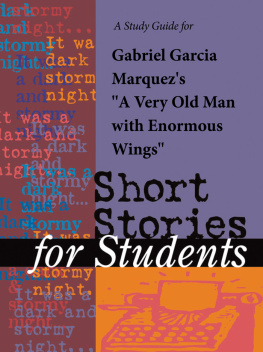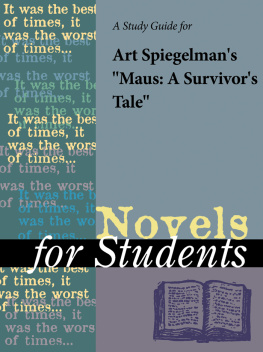TABLE OF CONTENTS
Guide
Short Stories for Students, Volume 13
Staff
Editor: Jennifer Smith.
Contributing Editors: Anne Marie Hacht, Michael L. LaBlanc, Ira Mark Milne, Elizabeth Thomason, Carol Ullmann.
Managing Editor, Content: Dwayne D. Hayes.
Managing Editor, Product: David Galens.
Publisher, Literature Product: Mark Scott.
Literature Content Capture: Joyce Nakamura, Managing Editor. Michelle Kazensky, Associate Editor.
Research: Victoria B. Cariappa, Research Manager. Cheryl Warnock, Research Specialist. Sarah Genik, Ron Morelli, Tamara Nott, Tracie A. Richardson, Research Associates. Nicodemus Ford, Research Assistant.
Permissions: Maria Franklin, Permissions Manager. Kim Davis, Permissions Associate.
Manufacturing: Mary Beth Trimper, Manager, Composition and Electronic Prepress. Evi Seoud, Assistant Manager, Composition Purchasing and Electronic Prepress. Stacy Melson, Buyer.
Imaging and Multimedia Content Team: Barbara Yarrow, Manager. Randy Bassett, Imaging Supervisor. Robert Duncan, Dan Newell, Imaging Specialists. Pamela A. Reed, Imaging Coordinator. Leitha Etheridge-Sims, Mary Grimes, David G. Oblender, Image Catalogers. Robyn V. Young, Project Manager. Dean Dauphinais, Senior Image Editor. Kelly A. Quin, Image Editor.
Product Design Team: Kenn Zorn, Product Design Manager. Pamela A. E. Galbreath, Senior Art Director. Michael Logusz, Graphic Artist.
Copyright Notice
Since this page cannot legibly accommodate all copyright notices, the acknowledgments constitute an extension of the copyright notice.
While every effort has been made to secure permission to reprint material and to ensure the reliability of the information presented in this publication, Gale neither guarantees the accuracy of the data contained herein nor assumes any responsibility for errors, omissions, or discrepancies. Gale accepts no payment for listing; and inclusion in the publication of any organization, agency, institution, publication, service, or individual does not imply endorsement of the editors or publisher. Errors brought to the attention of the publisher and verified to the satisfaction of the publisher will be corrected in future editions.
This publication is a creative work fully protected by all applicable copyright laws, as well as by misappropriation, trade secret, unfair competition, and other applicable laws. The authors and editors of this work have added value to the underlying factual material herein through one or more of the following: unique and original selection, coordination, expression, arrangement, and classification of the information.
All rights to this publication will be vigorously defended.
Copyright 2001
The Gale Group
27500 Drake Road
Farmington Hills, MI 483313535
All rights reserved including the right of reproduction in whole or in part in any form.
ISBN 0-7876-4265-7
ISSN 1092-7735
Printed in the United States of America.
10 9 8 7 6 5 4 3 2 1
This Way for the Gas, Ladies and Gentlemen
Tadeusz Borowski
1946
Introduction
In his introduction to the English translation of This Way for the Gas, Ladies and Gentleman, Jan Kott writes of Tadeusz Borowskis decision to render his Auschwitz stories in the first person: The identification of the author with the narrator was the moral decision of a prisoner who had lived through Auschwitzan acceptance of mutual responsibility, mutual participation, and mutual guilt for the concentration camp. Indeed, in a review for another authors book about the concentration camps, Borowski stated, It is impossible to write about Auschwitz impersonally. He defined as the first duty of Auschwitzers... to make clear just what camp is. It is where survival depended on a prisoners taking part in the murder and degradation of their fellow victims. But write that you, you were the ones who did this, Borowski intoned. That a portion of the sad fame of Auschwitz belongs to you as well.
In the collections title story, Borowski squarely fulfills his obligation. Seen through the eyes of a Polish gentile prisoner, as Borowski himself was, This Way for the Gas, Ladies and Gentleman describes a typical day at Auschwitz. The narrator joins in the task of unloading thousands of Jews from the cattle cars and sending them to their death in the gas chamber, all to acquire food and maybe a pair of shoes. Subject matter aside, Borowskis story is chilling and unforgettable in the success with which the narrator distances himself from his actions. As readers grow to understand that the narrator is forced to this extreme in order to continue to perform the work that guarantees his own existence, they become implicated themselves they become part of the community of the concentration camp.
Author Biography
Borowski was born in 1922 to a poor Polish family in what was then part of the Soviet Ukraine. In 1926, Borowskis father, accused of political dissidence, was sent to a labor camp, and when Borowski was eight years old, his mother was sent to Siberia. An aunt then took over the boys care. In 1932, Borowskis father was freed in a prisoner exchange program between Poland and the Soviet Union, and the two were reunited. Two years later, Borowskis mother rejoined the family in Warsaw.
The young Borowski was educated at a Franciscan boarding school. Borowski was 17 when Poland fell under German occupation at the start of World War II. Schools were closed down, so Borowski studied in underground classes and managed to graduate from secondary school. He then attended the underground Warsaw University, majoring in Polish language and literature. Already a budding writer, Borowski also worked as a stockboy and a night watchman.
In 1942, Borowski printed and distributed his first book of poetry, Gdziekolwiek ziemia (translated as Wherever the Earth). Borowski anonymously published this collection of metaphoric verse that centered on the death of civilized man in the German labor camps and then distributed it secretly. However, the Gestapo discovered his actions, and within weeks of the volumes release, Borowski and his fiancee, Maria, were arrested. He was sent to several prison camps before arriving at Auschwitz. To ensure his survival, Borowski got a job as an orderly in the camp hospital. As the Allied liberation forces drew close to Auschwitz, Borowski and other prisoners were moved to Dachau. The U.S. Army liberated the camp in May 1945.
Borowski was then transferred to a camp for displaced persons. He left the camp in September to search for his fiancee, whom he had last seen at Birkenau, the womens barracks near Auschwitz. He learned that she was living in Sweden, but he was unable to cross international borders to reach her. Borowski spent a short time in Munich and Paris before returning to Communist Poland in May 1946. His fiancee joined him in November, and they were married the following year.
Following his release, Borowski continued to write stories, including This Way for the Gas, Ladies and Gentlemen, which he produced at the displaced persons camp. Some of these stories as well as his poetry had been published in Poland before his return. Along with two other Polish Gentile writers, Borowski compiled




















